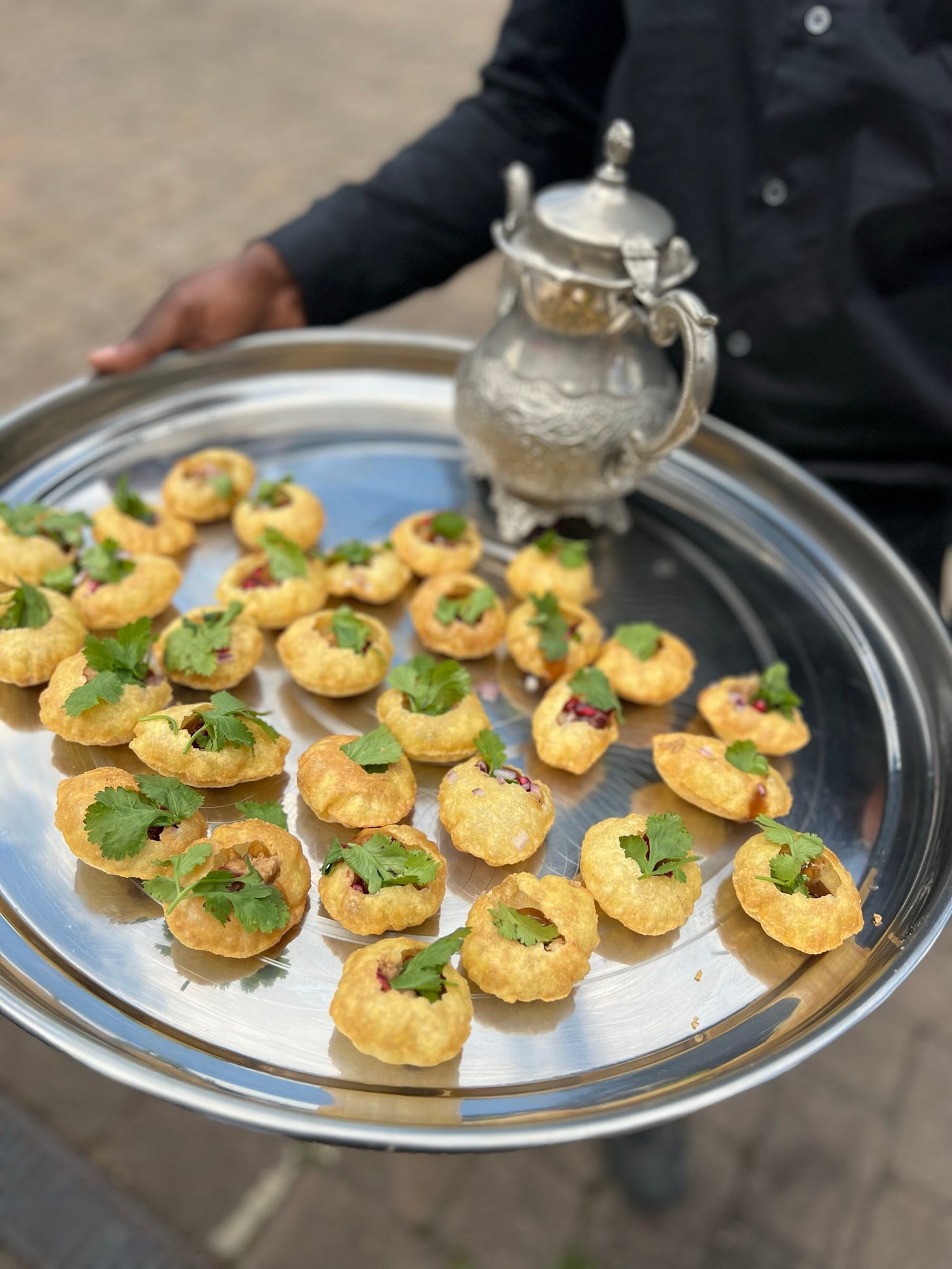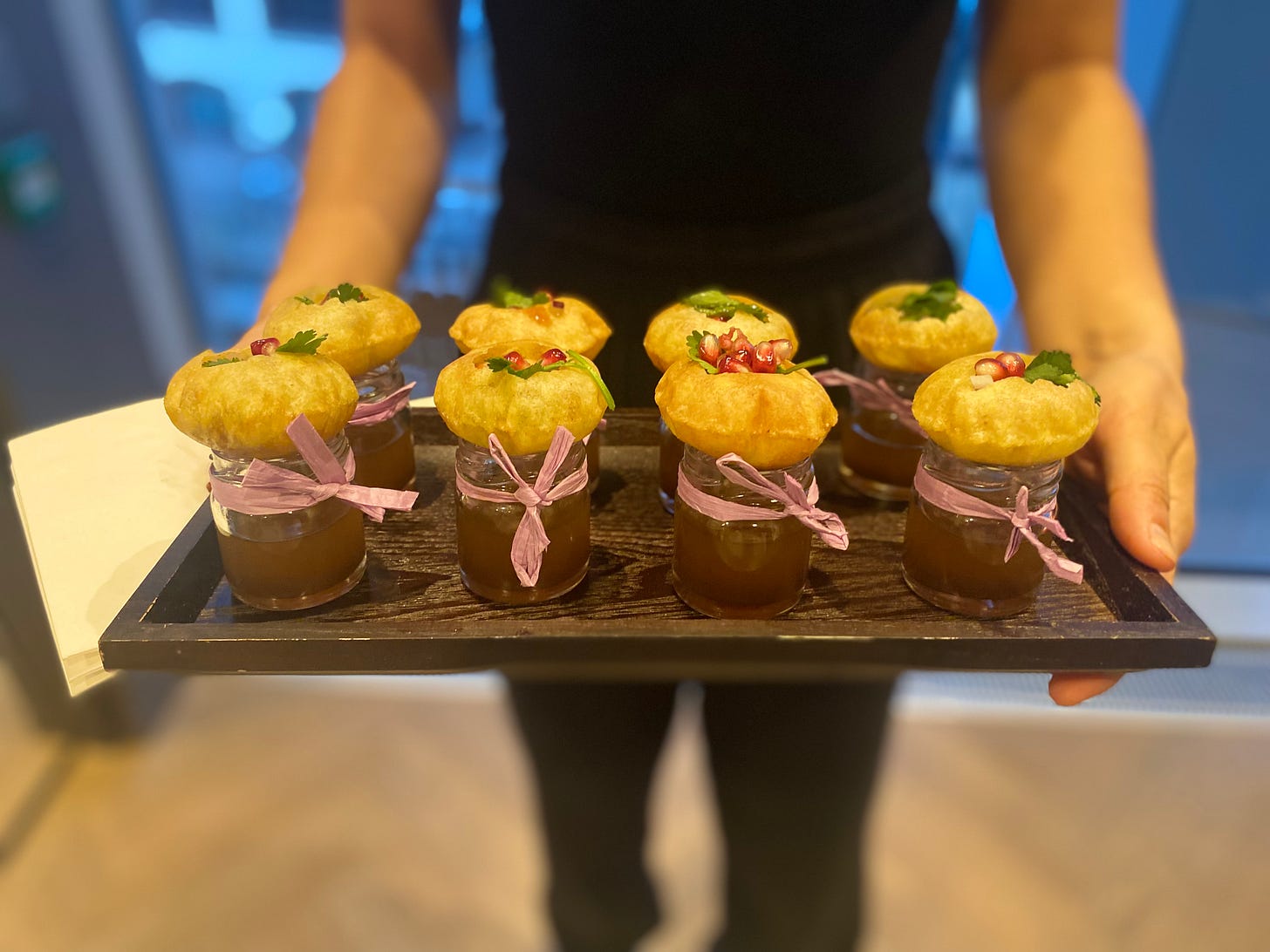Still Autumn: a case to serve Gol Gappay as canapés
a childhood memory of street food, from Lahore to London, and a simple recipe
Welcome to The Empress Market newsletter, written by me, Chef and Founder Numra. As with my cooking, I approach writing seasonally and, as the weather evolves and the seasons change, I unravel the theme in this monthly newsletter, through narrative and cooking notes. If you’re new here, thanks for joining me! It also might be helpful for you to know that I launched the autumn season with the October issue: The Perfect Bite.
This month, we’re going to talk about what happens when one bite is not enough . . .
Something about too much of a good thing? I don’t believe in such a thing, but I do live for canapés.
Canapés are the ultimate PERFECT BITE.
Gulp a canapé in one go and be met with a whirlwind of textures, bouncing diverse flavours against a tight and well-kept appearance. Canapés are designed to wet the appetite in anticipation of a meal.
Now, I have to tell you that Pakistani hospitality doesn’t have the rivaadj of canapés. I picked up the tradition of serving this fiddly food when I was freelancing for London-based catering companies.
A deși dastarkhaan puts the emphasis on abundance. Dishes must be laid out all at once and staged in high piles for a feast to unravel. Think about it as a one course and one stop experience type of buffet. Then, if you happen to catch extra dishes coming in late, my bet is that the host had run out of space on the table in the first instance, or that the guests demanded rounds of seconds.
Here, in the diaspora, us desis are slowly beginning to stagger our meals, introducing first courses to our eating traditions. The street food specialities of chaats and barbecue meats are being presented and served as starters at curry houses and wedding feasts.
Canapés - aka a single bite offered on a tray as a mingling tool at fancy weddings and gallery openings - go a step further. A canapé says PACE YOURSELF.
And I like a bit of both worlds. That is, to pace myself until I eat too much of that good thing.
If Pakistan doesn’t have an official canapé menu to choose from, I’m happy to stretch the rules of what, when and how food can be served and to introduce you to a Pakistani canapé of my own (re)making. It comes in the form of fried semolina puffs called Gol Gappa.
Strictly speaking, Gol Gappay (plural) are a desi street food, so let me tell you a bit about them first..
Gol Gappay, Pani Puri or Puchkas come with many names and filings. For those of you who aren’t familiar with them, they are fried semolina puffs stuffed with potato and spices, which are served with a spiced, flavoured water. The water is poured into the puff and eaten in one bite.
I really can’t be bothered to get into the futile debate about the origins of street food and answer questions about who does it better and what are the exact ingredients that qualify as regional specificities. I know plenty of desis across the divide who love to fight about authenticity and food ownership. In my opinion, such a discourse – stuck with essentialist ideas about what makes our food real – follows dated traditions and restrains us from cultural change. This, my friend, is the root cause of division in our community. Please google the India Pakistan relationship for more context, if you must!
Back to the Gol Gappa case. While the filling and name change depending on who is preparing the street food, two things always remain the same: the semolina puff must be served with a pairing of masala water.
Gol Gappay is what I’ve called them my whole life. The name is a play on what they look like and how you eat them – ‘gol’ as in round, ‘gappa’ as in you eat them in one GAPP! Again, this is what I’ve been told and what makes the most sense. We don’t need to start a paper on semantics about this, it’s not that deep.
Sometimes, when I say Pani Puri, it’s a slip of the tongue and, for me, that’s ok too.
My relationship with Gol Gappay is one of nostalgia, so the ingredients I choose to make mine are an effort to recreate my memories of a childhood in Pakistan. And, much like my relationship with Pakistan itself (we don’t have enough time to get into the topic today), my relationship with Gol Gappay is complicated.
So, I was never allowed to eat Gol Gappay as a kid. The fear of food poisoning from dirty water and potatoes being kept out for long periods under the scorching sun is real. And Gol Gappay are mainly made of spicy water and potatoes so, erm, yeah. My mum forbade us from eating this street food snack. While other children would be running around chasing fireflies in Race Course Park or playing with the fountain at Lawrence Garden in Lahore, I sat sullenly and watched others gobbling Gol Gappay.
Street Food vendors lined the winding cement paths in the parks.
You could order a plate of 6 and the vendor would assemble it in one swift motion for you, drawing the puffs from a glass case inside which the pre-fried puris were stored. One after another, he held the puffs in the palm of his hand, cracked them open with his thumb and filled them with chaat masala potatoes, raw onions and other delights (I say delights because I don't remember what went in exactly!). Then, with the help of a ladle, he poured the spicy, imli water from a bulbous terracotta into individual plastic cups and off went his customers, happy with their portion of mystery, murky water.
Some thoughts came to my mind as I sulked: I wish I had a tougher stomach. I wish my mum wasn’t so mean. I will eat Gol Gappay one day!
And, one day, my dad decided the sulking was too much. He was always quicker to cave as well, giving into my tantrums, so he took me by the hand and led me to someone he had judged to be a suitable and clean Gol Gappa vendor. Five Ruppees or so were exchanged for a plate of Gol Gappay. My dad passed me one puri and carefully poured the imli water over the cracked hollow.
“Now quickly eat it in one go before it falls apart”
I opened my mouth as wide as I could and shoved the puri in, shards of the pastry crumbling, water dribbling down my chin. It tasted stunning. First the crunch of the puri, then the fresh sweetness of the imli water. The chaat masala potato would follow, a creamy softness paired with earthy chickpeas. I remember a hint of sweetness, a touch of pomegranate or red onion. And the peppery, fresh coriander that rounded it all off.
I wanted another, and I ate all six of them in quick succession. I remember my dad laughing as he watched me, and as I barely stopped to breathe. I could have eaten another six if you had asked me, but I knew one plate was enough.
“Don’t tell your mother I let you eat Gol Gappay today,” he said, as we walked away hand in hand, both satisfied with our secret.
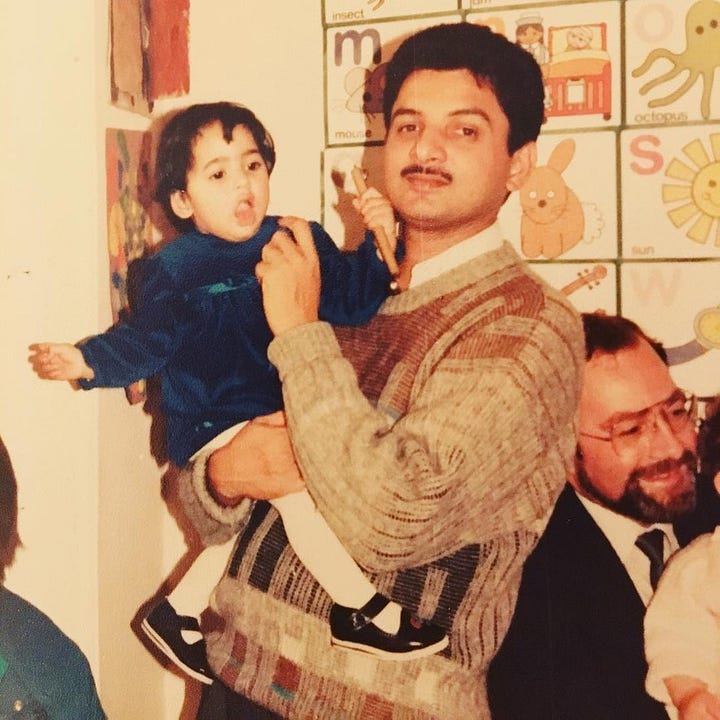
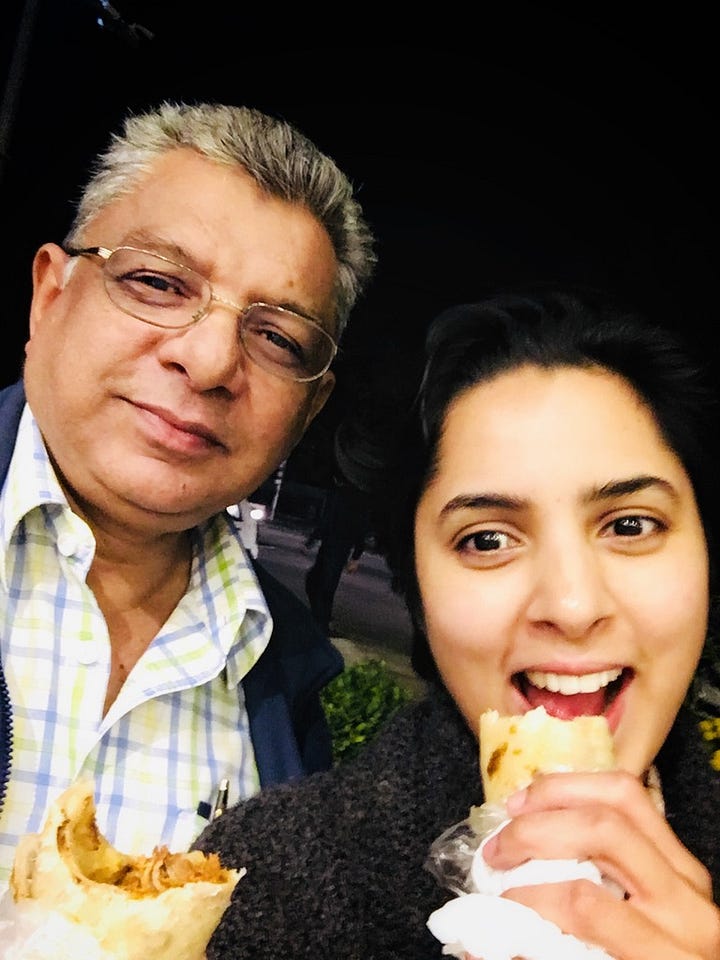
The following days blurred into one sick time, in and out of the bathroom (the secret didn’t last long!) and I never ate Gol Gappay in Pakistan again. Alright, as years went by, I did end up eating Gol Gappay at a street food cafe called Chatkhara, and they were great!
Yes, my story with Gol Gappay doesn’t end here as I often serve them as canapés at my catering events and supper clubs. I have made them countless times and developed my own recipe for the filling and the imli water. I serve the puris in an oversized silver thali and the flavoured water in vintage silver teapots. I love watching guests delicately handle each puff, then pour over the water, and I offer them the same advice my dad once gave me: “eat it quickly before it falls apart”. And, in one bite, they inhale the whole puri inside their mouth, giggling as they attempt not to make a mess. We laugh together, they become part of my memories of Gol Gappay, something I can hand over, and something I can keep as mine.
Numra x
PS. Gol Gappay, a recipe?
This recipe feels so simple to me that, as a chef, I feel silly sharing it. I suppose the beauty of this dish lies in its simplicity and, as in most cases in life, the simple things are what give us the greatest joy. My childhood memories of growing up in Lahore and how I share them with my community in London, that is what I’m sharing with you today.
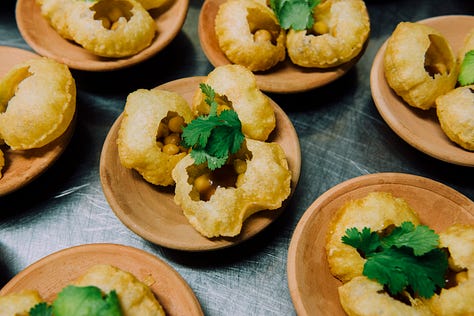
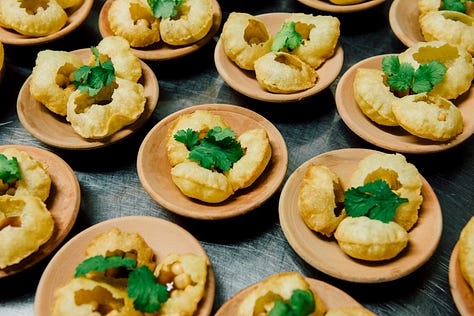
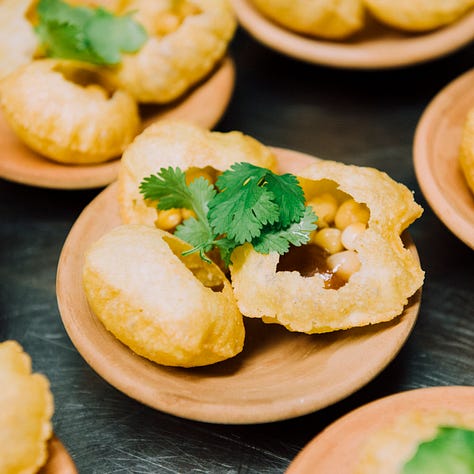
You can buy the ingredients for Gol Gappay from your local South Asian grocery store.
Notes on the puris -
One could make the puris from scratch, although I find that quite unnecessary. You can buy dry pastry discs and fry them at home, and they will puff up perfectly into delicate crispy balls. Alternatively, you can buy pre-fried puri shells, if you’re weary of your kitchen smelling of a fry up. They usually come in boxes of 40, and they are so delicate, you are likely to waste up to 10 puris during transit or if you’re too heavy-handed and crush the puris when making a hollow. I factor 2 per head, but I cannot determine how many one person will eat. I have been known to eat 37 in one sitting.
Ingredients -
1 box of pre-fried Gol Gappay
1 medium sized potato
Half a jar of chickpeas (The jarred chickpeas from Bold Bean co, Brindisa, Belazu, which are some of the up-market, high street brands, are softer in texture. You are welcome to use tinned chickpeas as well.)
1 tsp chaat masala
1 small red onion
1 handful of fresh pomegranate seeds
Tamarind sauce (this can’t be measured and you will see why!)
1 handful of fresh coriander leaves
Napkins
Imli Water
1 cup boiling water
¼ cup tamarind paste
¼ cup crumbled jaggery
1.5 tsp chaat masala
½ tsp black salt
¼ tsp white pepper
1 tsp cumin seed powder
1 tsp coriander seed powder
1 tsp salt (to taste)
Method
To make the water, add all the ingredients in a heat proof jar. Screw on the lid and give it a good shake, until the sugar and tamarind dissolve. Leave aside to serve later.
Peel and dice the potato into 1cm chunks.
Boil the potato chunks in salted water, until they’re cooked through. Don’t overcook the potato though: they should hold together still. You can test this by scooping one piece out with a spoon and taste it.
Drain the potatoes, add the chickpeas and the chaat masala. Mix together, gently crushing the potatoes and bringing everything together.
Finely dice the red onion. Set aside.
In terms of timing for what comes next, which is the assembling stage of the recipe, I recommend waiting until 5 to 10 minutes before you’re due to serve the dish before filling up the semolina puffs.
Crack the top of the semolina puff shell with the tip of a tablespoon handle. I’m being specific with the utensil here because it’s easy to break the whole shell!
Fill the shell with half a teaspoon of the boiled potato and chickpea mixture, a sprinkle of red onion, pomegranate seeds, a drop of tamarind sauce, and a few leaves of fresh coriander.
Serve the imli water alongside the assembled puffs and some napkins. Now encourage your guests to pour the water over the puffs themselves, and to eat the Gol Gappa immediately. This is when the napkins come into play - eating Gol Gappay can be a messy affair, trust me on this one.





